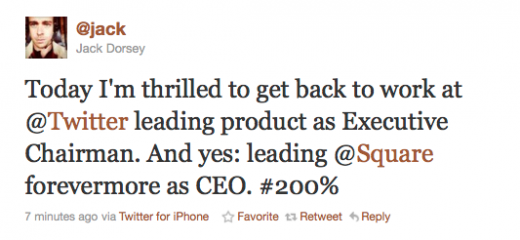
While Twitter’s recently released traffic figures revealed insight into how many people are using the site and just how they’re using it, it received mixed reaction. Some saw the traffic figures as high, but it also revealed how much Twitter really relies on the power users of the site to continually provide content for those that would be considered ‘lurkers’.
This puts the site in a dangerous position anyway, as all it takes is a few groups of people to leave the site for its use to really be questionable. But what shows Twitter in an even more fragile state is the internal organisation at the company in what has been a pretty turbulent year for them so far. Below we look at just how many changes Twitter has gone through this year, and ask if they can really survive?
The return of Jack (sort of)
Jack Dorsey, one of the co-founders of Twitter, was the first CEO at Twitter before he left the post in October 2008. Between then and early 2011 his focus seemed very much outside of Twitter, despite remaining as chairman of the board. He founded and headed up the mobile payment system Square, which has pretty much been going from strength to strength and seemingly making good money for such a young startup. In March 2011 however, Jack returned to the post of CEO at Twitter, announced via a tweet:
While he may have returned as CEO of Twitter, as shown in the tweet above, he is still very much involved in Square. Both of these are huge companies and whether someone can adequately lead both of them at the same time is questionable, despite the 200% that Jack may now be giving. What Twitter, or any company, needs at the top during a stage of growth like this is someone that is focused on that company only. Someone with 2 jobs on the go isn’t what Twitter needs right now.
Meanwhile Biz & Ev depart
Not long after Jack returned to Twitter, there was more turbulence in store, as co-founders Evan Williams and Biz Stone left Twitter along with Jason Goldman to relaunch the company that Twitter was born through: The Obvious Corporation.
They left in June 2011, shortly after Jack’s return. While the timing may have been well orchestrated within Twitter, Biz and Ev would hardly have left without the return of Jack. Again, this is an incredible amount of turbulence for a company to take within a very short amount of time.
Board members reduced
Most recently, Twitter announced that its board of directors is being reduced from nine members, to seven. Bijan Sabet and Fred Wilson are venture capitalists and original investors in Twitter. the move is being reported as an outcome of a recent financing round that saw their stake in Twitter reduced, causing them to leave the board. It’s yet more changes at the top at a time when they probably didn’t need it.
#TwitterNYC
Amidst all the change within the company, Twitter recently decided to open an office in New York in order to take their focus outside of Silcon Valley exclusively. Again the news was released via a tweet, this time from the Twitter PR account.
Opening a new office is never an easy undertaking no matter what size company you are, and the move came at what was already a busy time for Twitter, with new site functionality announced and a frequently changing team of directors. Moving outside of Silicon Valley to focus on New York shows that there’s more changes ahead for Twitter as it expands the company in new ways.
Twitter does photos now
 Aside from the changes to Twitter’s business structure and focus, there have also been some key changes to the site. Earlier this year, Twitter announced a huge overhaul to its site functionality, with the main change being the addition of photos and videos. These were added into Twitter’s own search results, as well as adding in the functionality to post them directly from your profile.
Aside from the changes to Twitter’s business structure and focus, there have also been some key changes to the site. Earlier this year, Twitter announced a huge overhaul to its site functionality, with the main change being the addition of photos and videos. These were added into Twitter’s own search results, as well as adding in the functionality to post them directly from your profile.
It also came via a partnership with Photobucket, who are hosting the photos. This was a much needed feature from Twitter but it also begged the question, why they didn’t Twitter do it sooner? It looked like one of the first things Jack was taking care of, following his return to the site.
Buying their biggest competitor
Following a turbulent time with developers, Twitter made another move that it should have done a long time ago, with the acquisition of its biggest competitor: Tweetdeck. Now this may not be a competitor in the traditional sense, as Tweetdeck obviously runs on Twitter’s API, but it was the most popular competing service to what Twitter was offering itself. It was certainly a smart move by Twitter, but an acquisition like this will never be seamless, so it adds another layer onto Twitter’s internal organisation that will need to be well managed, so the user experience isn’t compromised. What Twitter needs now is continuity.
No to developers. Oh wait, actually yes
Linked to its purchase of Tweetdeck has been Twitter’s relationship with developers this year, which has perhaps been the most turbulent area within the company. In March it effectively killed its developer community, when it told developers to stop developing new clients for Twitter. The move came as it wanted to offer a consistent experience for users, but given how much Twitter’s development community had contributed to the growth of the site (see above acquisition), it seemed like a misguided move.
Twitter itself seemed to realise this, and in August this year, it re-opened its relationship with developers by releasing a new toolkit that made for easier development of CSS based apps. From the outside it looked like Twitter hadn’t really decided how to handle developers, which is a crucial part of the company’s growth.
So what now?
The items above are just a few of the changes that Twitter has gone through this year, not mentioning another site redesign, a changing ad product, the demise of search.twitter.com and lots more. The question remains of whether these decisions and changes are really in the best interest for Twitter, or whether they’re representative of a company that seems to have an ever-changing direction and focus.
Look at it from the point of view of Twitter being about 140 characters and its focus is clear. Twitter has never messed with that staple of its site. But as it grows as a social network and service, from the outside it looks as if it is heading in many different directions, which along a frequently changing team at the helm, will make for even more turbulence for Twitter in the months ahead. And you thought TechCrunch had problems…
Get the TNW newsletter
Get the most important tech news in your inbox each week.







